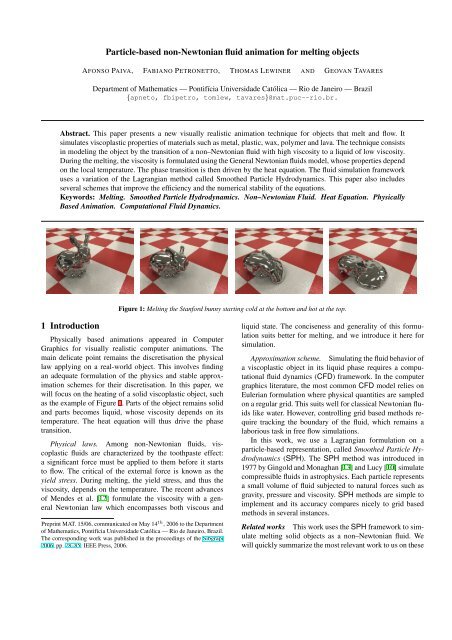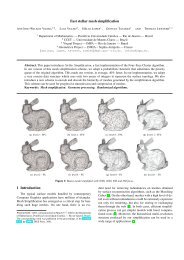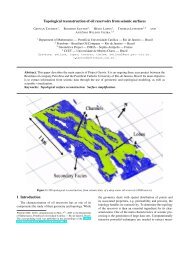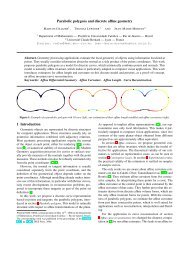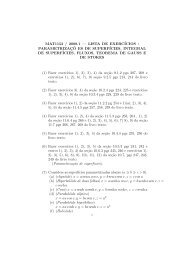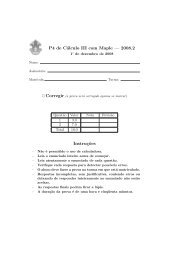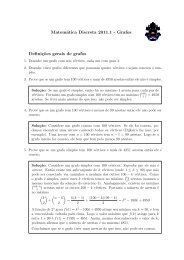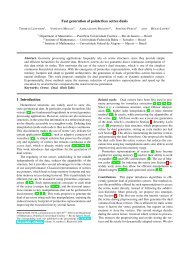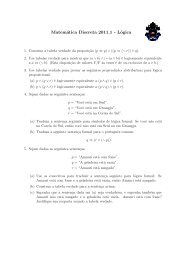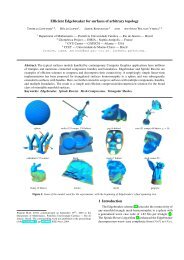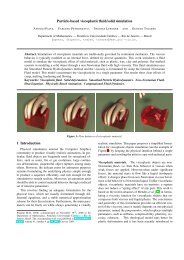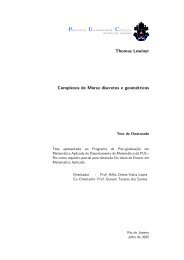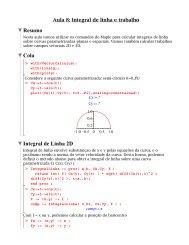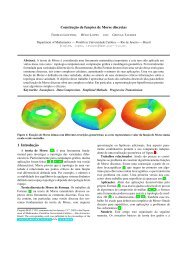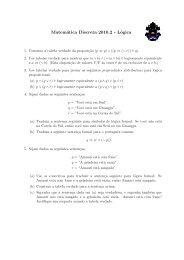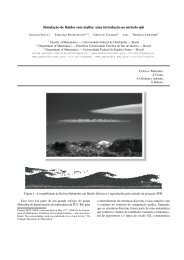Particle-based non-Newtonian fluid animation for melting ... - PUC-Rio
Particle-based non-Newtonian fluid animation for melting ... - PUC-Rio
Particle-based non-Newtonian fluid animation for melting ... - PUC-Rio
Create successful ePaper yourself
Turn your PDF publications into a flip-book with our unique Google optimized e-Paper software.
<strong>Particle</strong>-<strong>based</strong> <strong>non</strong>-<strong>Newtonian</strong> <strong>fluid</strong> <strong>animation</strong> <strong>for</strong> <strong>melting</strong> objects<br />
AFONSO PAIVA, FABIANO PETRONETTO, THOMAS LEWINER AND GEOVAN TAVARES<br />
Department of Mathematics — Pontifícia Universidade Católica — <strong>Rio</strong> de Janeiro — Brazil<br />
{apneto, fbipetro, tomlew, tavares}@mat.puc--rio.br.<br />
Abstract. This paper presents a new visually realistic <strong>animation</strong> technique <strong>for</strong> objects that melt and flow. It<br />
simulates viscoplastic properties of materials such as metal, plastic, wax, polymer and lava. The technique consists<br />
in modeling the object by the transition of a <strong>non</strong>–<strong>Newtonian</strong> <strong>fluid</strong> with high viscosity to a liquid of low viscosity.<br />
During the <strong>melting</strong>, the viscosity is <strong>for</strong>mulated using the General <strong>Newtonian</strong> <strong>fluid</strong>s model, whose properties depend<br />
on the local temperature. The phase transition is then driven by the heat equation. The <strong>fluid</strong> simulation framework<br />
uses a variation of the Lagrangian method called Smoothed <strong>Particle</strong> Hydrodynamics. This paper also includes<br />
several schemes that improve the efficiency and the numerical stability of the equations.<br />
Keywords: Melting. Smoothed <strong>Particle</strong> Hydrodynamics. Non–<strong>Newtonian</strong> Fluid. Heat Equation. Physically<br />
Based Animation. Computational Fluid Dynamics.<br />
Figure 1: Melting the Stan<strong>for</strong>d bunny starting cold at the bottom and hot at the top.<br />
1 Introduction<br />
Physically <strong>based</strong> <strong>animation</strong>s appeared in Computer<br />
Graphics <strong>for</strong> visually realistic computer <strong>animation</strong>s. The<br />
main delicate point remains the discretisation the physical<br />
law applying on a real-world object. This involves finding<br />
an adequate <strong>for</strong>mulation of the physics and stable approximation<br />
schemes <strong>for</strong> their discretisation. In this paper, we<br />
will focus on the heating of a solid viscoplastic object, such<br />
as the example of Figure 1. Parts of the object remains solid<br />
and parts becomes liquid, whose viscosity depends on its<br />
temperature. The heat equation will thus drive the phase<br />
transition.<br />
Physical laws. Among <strong>non</strong>-<strong>Newtonian</strong> <strong>fluid</strong>s, viscoplastic<br />
<strong>fluid</strong>s are characterized by the toothpaste effect:<br />
a significant <strong>for</strong>ce must be applied to them be<strong>for</strong>e it starts<br />
to flow. The critical of the external <strong>for</strong>ce is known as the<br />
yield stress. During <strong>melting</strong>, the yield stress, and thus the<br />
viscosity, depends on the temperature. The recent advances<br />
of Mendes et al. [12] <strong>for</strong>mulate the viscosity with a general<br />
<strong>Newtonian</strong> law which encompasses both viscous and<br />
Preprint MAT. 15/06, communicated on May 14 th , 2006 to the Department<br />
of Mathematics, Pontifícia Universidade Católica — <strong>Rio</strong> de Janeiro, Brazil.<br />
The corresponding work was published in the proceedings of the Sibgrapi<br />
2006, pp. 78–85. IEEE Press, 2006.<br />
liquid state. The conciseness and generality of this <strong>for</strong>mulation<br />
suits better <strong>for</strong> <strong>melting</strong>, and we introduce it here <strong>for</strong><br />
simulation.<br />
Approximation scheme. Simulating the <strong>fluid</strong> behavior of<br />
a viscoplastic object in its liquid phase requires a computational<br />
<strong>fluid</strong> dynamics (CFD) framework. In the computer<br />
graphics literature, the most common CFD model relies on<br />
Eulerian <strong>for</strong>mulation where physical quantities are sampled<br />
on a regular grid. This suits well <strong>for</strong> classical <strong>Newtonian</strong> <strong>fluid</strong>s<br />
like water. However, controlling grid <strong>based</strong> methods require<br />
tracking the boundary of the <strong>fluid</strong>, which remains a<br />
laborious task in free flow simulations.<br />
In this work, we use a Lagrangian <strong>for</strong>mulation on a<br />
particle-<strong>based</strong> representation, called Smoothed <strong>Particle</strong> Hydrodynamics<br />
(SPH). The SPH method was introduced in<br />
1977 by Gingold and Monaghan [13] and Lucy [10] simulate<br />
compressible <strong>fluid</strong>s in astrophysics. Each particle represents<br />
a small volume of <strong>fluid</strong> subjected to natural <strong>for</strong>ces such as<br />
gravity, pressure and viscosity. SPH methods are simple to<br />
implement and its accuracy compares nicely to grid <strong>based</strong><br />
methods in several instances.<br />
Related works This work uses the SPH framework to simulate<br />
<strong>melting</strong> solid objects as a <strong>non</strong>–<strong>Newtonian</strong> <strong>fluid</strong>. We<br />
will quickly summarize the most relevant work to us on these
A. Paiva, F. Petronetto, T. Lewiner and G. Tavares 2<br />
three topics.<br />
Smoothed <strong>Particle</strong> Hydrodynamics. The SPH method<br />
was introduced in the computer graphics community by Desbrun<br />
and Cani in [5], where they used SPH to simulate de<strong>for</strong>mable<br />
bodies. Müller et al. [19] then used the SPH approach<br />
<strong>for</strong> simulating incompressible <strong>fluid</strong>s with surface tension.<br />
Furthermore, they introduced point–splatting to capture<br />
the <strong>fluid</strong> free surface. Recently SPH methods became very<br />
popular in the special effects industry where it was used to<br />
simulate lava flow in the third part of The Lord of the Rings<br />
trilogy (http://www.nextlimit.com).<br />
Non–<strong>Newtonian</strong> <strong>fluid</strong>s. There are few works in computer<br />
graphics <strong>for</strong> <strong>non</strong>-<strong>Newtonian</strong> <strong>fluid</strong>s. Goktekin et al. [6]<br />
proposed a grid–<strong>based</strong> method to compute the stress tensor<br />
of these <strong>fluid</strong>s. They use a linear Maxwell model with<br />
von Mises plastic yield condition. Clavet et al. [3] use SPH<br />
with a linear combination of elastic springs between particles<br />
driven plastic yield condition. Another method using SPH<br />
was proposed by Mao and Yang [11], where the stress tensor<br />
derives from a corotational Maxwell model.<br />
Melting. The idea of simulating <strong>melting</strong> and flowing of<br />
solids objects by coupling viscosity with temperature appeared<br />
in different contexts. Carlson et al. [2] use an Eulerian<br />
grid-<strong>based</strong> <strong>fluid</strong> method. They further need an implicit<br />
integrator to compensate the instability of the grid–<strong>based</strong> approach.<br />
Wei et al. [22] use cellular automata and replace<br />
Navier–Stokes equations by simple rules in each automata.<br />
Müller et al. [20] create a point–<strong>based</strong> framework to simulate<br />
elastoplastic objects with von Mises plastic yield condition.<br />
They use moving least squares (MLS) <strong>for</strong> approximating the<br />
velocity gradient. Finally, Keiser et al. in [8] introduces traditional<br />
SPH method in the previous framework with usual<br />
viscoplastic modeling.<br />
Contributions. This paper introduces two new elements to<br />
the <strong>melting</strong> simulation. First, we use General <strong>Newtonian</strong><br />
Fluid model [12] to compute the viscosity (see Section 2).<br />
Its concise <strong>for</strong>mulation reduces the number of parameters <strong>for</strong><br />
yield modeling and allows simpler relation with the temperature.<br />
Moreover, since this <strong>for</strong>mulation covers viscoplastic<br />
<strong>fluid</strong>s within a single equation, it treats the whole object at<br />
once and avoids delicate detection of the viscosity transition.<br />
Moreover, we introduce in the heat equation approximation<br />
a more stable Laplacian operator on the particles (see<br />
Section 3). This approximation already improved Poisson<br />
simulations [4] by involving differences of first derivatives<br />
instead of second derivatives.<br />
We also introduce several numerical improvements in the<br />
method. First, we introduce the use of XSPH [14] <strong>for</strong> avoiding<br />
the <strong>for</strong>mation of stable clusters of particles (see Section<br />
3). Then, we reintroduce the artificial viscosity [5], but<br />
<strong>for</strong> <strong>melting</strong> simulation. We also chose the continuity equation<br />
<strong>for</strong> density (equation (6)) to avoids particle outliers.<br />
Finally, our implementation uses an adaptive time step <strong>for</strong><br />
each iteration <strong>based</strong> on the Courant-Friedrichs-Lewy condition<br />
(see Section 4).<br />
2 Formulation of the physical laws<br />
Computational <strong>fluid</strong> dynamics (CFD) aims at prediction<br />
<strong>fluid</strong> behavior through Navier–Stokes equations. These equations<br />
are commonly solved using conventional Eulerian <strong>for</strong>mulation<br />
with grid-<strong>based</strong> methods such as finite differences<br />
and finite elements. In this work, we chose an alternative<br />
method driven by the Lagrangian <strong>for</strong>mulation. As opposed<br />
to the Eulerian approach, the Lagrangian <strong>for</strong>mulation does<br />
not require advective term, which suits well <strong>for</strong> meshless<br />
methods such as SPH. We will introduce now this <strong>for</strong>mulation<br />
and the General <strong>Newtonian</strong> Fluid model [12] that models<br />
our viscoplastic object, together with our heating model.<br />
The reader will find further details on CFD in Anderson’s<br />
book [1].<br />
Lagrangian <strong>for</strong>mulation. Navier-Stokes equations can be<br />
<strong>for</strong>mulated by the following two equations describing the<br />
conservation of the mass (equation (1)) and of the momentum<br />
(equation (2)).<br />
dρ<br />
= −ρ∇.v (1)<br />
dt<br />
dv<br />
dt = − 1 ρ ∇p + 1 ∇.S + g (2)<br />
ρ<br />
where t denotes the time, v the velocity vector, ρ the density,<br />
p the pressure, g the gravity acceleration vector and S the<br />
viscoplastic stress tensor. This last term plays a fundamental<br />
role in <strong>melting</strong> simulation.<br />
Generalized <strong>Newtonian</strong> Fluid model. For <strong>non</strong>-<strong>Newtonian</strong><br />
<strong>fluid</strong>s, the stress tensor is a <strong>non</strong>linear function of the de<strong>for</strong>mation<br />
tensor D = ∇v + (∇v) T . For our simulation, we<br />
will use the Generalized <strong>Newtonian</strong> Liquid model proposed<br />
by Mendes et al. [12], where the stress tensor S is given by<br />
S = η (D) D, where the apparent<br />
√<br />
viscosity η depends on the<br />
1<br />
intensity of de<strong>for</strong>mation D =<br />
2 · trace (D)2 . The viscosity<br />
function η is then given by:<br />
(<br />
η (D) = (1 − exp [− (J + 1) D]) D n−1 + 1 )<br />
(3)<br />
D<br />
where n is the behavior of power–law index and J is the<br />
jump number.<br />
The jump number J is a new rheological parameter of a<br />
viscoplastic <strong>fluid</strong> which combines previous ones such as the<br />
yield stress and the consistency index. In our simulation, we<br />
fixed n = 1 2<br />
, and let only the jump number J vary with the<br />
temperature.<br />
Heating and <strong>melting</strong>. The <strong>melting</strong> of volumetric objects<br />
corresponds to a phase transition from solid to <strong>fluid</strong>. We<br />
can model this transition by varying the viscosity according<br />
to the temperature of each particle. This model was used<br />
in other <strong>animation</strong> frameworks, either using grid-<strong>based</strong> approach<br />
[2] or particle-<strong>based</strong> approach [8].<br />
The time variation of the temperature is described by the<br />
The corresponding work was published in the proceedings of the Sibgrapi 2006, pp. 78–85. IEEE Press, 2006.
3 <strong>Particle</strong>-<strong>based</strong> <strong>non</strong>-<strong>Newtonian</strong> <strong>fluid</strong> <strong>animation</strong> <strong>for</strong> <strong>melting</strong> objects<br />
(a) Initial temperature. (b) 500 iterations. (c) 1060 iterations. (d) 3000 iterations.<br />
Figure 2: Temperature of the 9727 particles of the bunny of Figure 1: the dark blue parts are below the <strong>melting</strong> point, and thus remain solid.<br />
Observe that the left ear of the bunny gets colder after touching the body.<br />
following heat equation, involving the temperature T and the<br />
thermal diffusion constant k:<br />
dT<br />
dt = k∇2 T (4)<br />
When the temperature of some part of the object increases<br />
and reaches the <strong>melting</strong> point, it becomes liquid (see Figure<br />
2). The jump number J then decreases according to the<br />
temperature. We will model the jump number as decreasing<br />
linearly with respect to the temperature:<br />
J (T ) = (1 − u)J max − uJ min<br />
with u = (T −T min )/(T max −T min ). Note that the viscosity<br />
function of equation (3) thus decreases when temperature<br />
increases and vice-versa.<br />
3 <strong>Particle</strong>–<strong>based</strong> approximation scheme<br />
We will use here the Smoothed <strong>Particle</strong> Hydrodynamics<br />
(SPH) framework <strong>for</strong> simulating the <strong>fluid</strong> behavior. In our<br />
<strong>animation</strong> framework, we use the <strong>for</strong>mulation of SPH <strong>for</strong><br />
incompressible <strong>fluid</strong> [15]. A wide review of SPH methods<br />
can be found in Monaghan’s survey [17].<br />
The SPH principles are reviewed in section 3(a) Smoothed<br />
<strong>Particle</strong> Hydrodynamics. It requires a discretisation of the different<br />
terms of the governing equations: section 3(b) <strong>Particle</strong><br />
approximation of continuity describes the approximation of the<br />
density <strong>for</strong> the continuity equation (1), section 3(c) <strong>Particle</strong><br />
approximation of the momentum describes the approximation of<br />
the pressure and the stress tensor of the momentum equation<br />
(2). Sections 3(d) and 3(e) present corrections <strong>for</strong> the<br />
viscosity and the velocity. Finally, section 3(f) Laplacian approximation<br />
introduces our approximation of the Laplacian in<br />
the heat equation (4).<br />
(a) Smoothed <strong>Particle</strong> Hydrodynamics<br />
The key idea of SPH is to replace the <strong>fluid</strong> by a set<br />
of particles (see Figure 3). The dynamics of the <strong>fluid</strong> is<br />
then naturally governed by the Lagrangian version of the<br />
Navier-Stokes equations introduced in the last Section. The<br />
local <strong>fluid</strong> properties such as mass and volume are attached<br />
to each particle and interpolated in-between particles. This<br />
interpolation uses a smoothing kernel W on the particles in<br />
a radius of h. A scalar field A(x) and its associated gradient<br />
vector field ∇A(x) at point x are interpolated using the<br />
particles j within a disk of radius h around x as follows:<br />
A(x) =<br />
∇A(x) =<br />
n∑<br />
A(x j ) m j<br />
W (x − x j , h) (5)<br />
ρ j<br />
j=i<br />
n∑<br />
A(x j ) m j<br />
∇W (x − x j , h)<br />
ρ j<br />
j=i<br />
where n is the number of neighboring particles, j the particle<br />
index, x j the particle position, m j the particle mass and ρ j<br />
the particle density.<br />
Figure 4: Quintic smoothing kernel: the particles farther than the<br />
smoothing length h are not considered in the convolution.<br />
In this work, we choose a piecewise quintic smoothing<br />
kernel function (see Figure 4), ( )<br />
W (x−x j , h) = 3<br />
359 πh3 ‖x−xj ‖ · w<br />
h<br />
, with:<br />
⎧<br />
(3−q) ⎪⎨<br />
5 −6(2−q) 5 + 15(1−q) 5 ; 0 ≤ q < 1<br />
(3−q)<br />
w(q) =<br />
5 −6(2−q) 5 ; 1 ≤ q < 2<br />
(3−q) ⎪⎩<br />
5 ; 2 ≤ q ≤ 3<br />
0 ; q > 3<br />
Preprint MAT. 15/06, communicated on May 14 th , 2006 to the Department of Mathematics, Pontifícia Universidade Católica — <strong>Rio</strong> de Janeiro, Brazil.
A. Paiva, F. Petronetto, T. Lewiner and G. Tavares 4<br />
Figure 3: SPH schemes deal gracefully with complex topological of the chair surface.<br />
(b) <strong>Particle</strong> approximation of continuity<br />
Density is usually approximate in SPH systems using the<br />
density summation, which follows directly from the SPH<br />
approximation of equation (5):<br />
ρ i =<br />
n∑<br />
m j W (x i − x j , h)<br />
j=i<br />
However, to ensure the physical meaning of the approximation,<br />
we need to introduce a symmetrization between the<br />
pressure and the local velocity [9]. In particular, the density<br />
summation approach has a particle deficiency near the<br />
<strong>fluid</strong> interface, which leads to spurious results. Moreover, it<br />
requires more computational ef<strong>for</strong>ts since the density must<br />
be evaluated be<strong>for</strong>e other parameters, such as pressure. We<br />
there<strong>for</strong>e chose another approximation <strong>for</strong> the density, using<br />
the following SPH version of continuity equation (1):<br />
dρ i<br />
dt = ρ i<br />
n∑<br />
j=1<br />
m j<br />
ρ j<br />
(v i − v j ) .∇ i W (x ij , h) . (6)<br />
where v i and v j are velocities at particles i and j respectively,<br />
and x ij = x i − x j .<br />
(c) <strong>Particle</strong> approximation of the momentum<br />
Pressure. The modeling of pressure remains a delicate<br />
point <strong>for</strong> SPH simulations of incompressible <strong>fluid</strong>s, due<br />
to the lack of explicit control of the local density. Since<br />
SPH suits better <strong>for</strong> compressible <strong>fluid</strong>, we approximate the<br />
incompressible <strong>fluid</strong> by a quasi-compressible <strong>fluid</strong> through<br />
an equation of state [15] <strong>for</strong> the pressure. We use the one<br />
proposed by Morris et al. [18]:<br />
p i = c 2 (ρ i − ρ 0 ) (7)<br />
where p i is the pressure at particle i, c the speed of sound,<br />
which represents the fastest velocity of a wave propagation<br />
in that medium, and ρ 0 is a reference density. This equation<br />
of state is very similar with the ideal gas equation of state<br />
used by Desbrun and Cani [5].<br />
After updating the pressure at all particles using equation<br />
(7), we can evaluate the pressure term in equation (2)<br />
at each particle i using a symmetrization similar to the density<br />
case [9]:<br />
− 1 ρ i<br />
∇p i = −<br />
n∑<br />
j=1<br />
m j<br />
(<br />
p i<br />
ρ 2 i<br />
+ p j<br />
ρ 2 j<br />
)<br />
∇ i W (x ij , h).<br />
Stress tensor. In order to compute the stress tensor S i =<br />
η (D i ) D i at each particle i, where η (D i ) is given by the<br />
equation (3), we must pre-compute the de<strong>for</strong>mation tensor:<br />
D i = ∇v i + (∇v i ) T<br />
where the velocity is evaluated by the following equation:<br />
∇v i =<br />
n∑<br />
j=1<br />
m j<br />
ρ j<br />
(v j − v i ) ⊗ ∇ i W (x ij , h) .<br />
Finally, after updating of the stress tensor S i at each<br />
particle i, the stress term in equation (2) can be approximated<br />
by:<br />
1<br />
ρ i<br />
∇.S i =<br />
n∑<br />
j=1<br />
m j<br />
(d) Viscosity correction<br />
ρ i ρ j<br />
(S i + S j ) .∇ i W (x ij , h) .<br />
To avoid numerical instabilities due to oscillations in the<br />
velocity vector field, which may ruin the simulation, a common<br />
technique adds an artificial viscous stress term in the<br />
SPH approximation of the linear momentum (equation (2))<br />
as follows:<br />
dv i<br />
dt ← dv i<br />
dt − n ∑<br />
j=1<br />
m j<br />
ρ i<br />
∏<br />
ij ∇ iW (x ij , h) . (8)<br />
The effect of the artificial viscous stress is given by the<br />
term:<br />
and<br />
⎧<br />
⎪⎨ −αµ ij c+βµ 2 ij<br />
∏<br />
ij = 0.5(ρ i +ρ j )<br />
, (v i − v j ) .(x i − x j ) < 0<br />
⎪ ⎩<br />
0, (v i − v j ) .(x i − x j ) ≥ 0<br />
µ ij = h (v i − v j ) .(x i − x j )<br />
|x i − x j | 2 + 0.01h 2<br />
where α corresponds to bulk viscosity and β corresponds to<br />
von Neumann-Ritchmyer viscosity [17].<br />
The corresponding work was published in the proceedings of the Sibgrapi 2006, pp. 78–85. IEEE Press, 2006.
5 <strong>Particle</strong>-<strong>based</strong> <strong>non</strong>-<strong>Newtonian</strong> <strong>fluid</strong> <strong>animation</strong> <strong>for</strong> <strong>melting</strong> objects<br />
(a) 20 iterations. (b) 550 iterations. (c) 780 iterations. (d) 1320 iterations.<br />
Figure 5: Melting a completely liquid Gargoyle model using 6976 particles: the color codes the velocity of each particle. The stability of the<br />
method preserves the shape of the object without explicit mesh representation even after many iterations.<br />
(e) XSPH Velocity correction<br />
Algorithm 1 <strong>Particle</strong> dynamics<br />
1: repeat<br />
To prevent particle inter–penetration, which may result<br />
2: <strong>for</strong> each particle i do<br />
in stable clusters of particles, Monaghan [14] introduced<br />
3: Update derivative density (equation 6)<br />
an improvement called XSPH velocity-correction. In XSPH<br />
4: Update acceleration (equation 2)<br />
(X means unknown), each particle i moves in the following<br />
5: Correct acceleration (equation 8)<br />
way:<br />
6: Update derivative temperature (equation 4)<br />
7: end <strong>for</strong><br />
n∑ m j<br />
v i ← v i + ε<br />
0.5 (ρ<br />
j=1 i + ρ j ) (v 8: <strong>for</strong> each particle i do<br />
j − v i ) W (x ij , h) (9)<br />
9: Update x i , v i , T i and ρ i with Leap-Frog scheme<br />
10: Correct v i with XSPH (equation 9)<br />
where ε ∈ [0, 1].<br />
11: Update p i (equation 7)<br />
The XSPH technique consists in computing an average 12: Update viscosity (equation 3)<br />
velocity from the velocities of the neighboring particles, it 13: end <strong>for</strong><br />
helps to keep particles of an incompressible flow to move 14: Update particle neighbors<br />
more orderly.<br />
15: Update △t using CFL condition (equation 10)<br />
16: time = time + △t<br />
(f) Laplacian approximation<br />
17: until time < time total<br />
The Heat equation (4), which governs the phase transition<br />
from solid to <strong>fluid</strong>, requires an approximation <strong>for</strong> the Laplacian<br />
of the temperature ∇ 2 T i . This second derivative can be 4 Results and Implementation<br />
approximated using the normal SPH convolution by the use<br />
In implementing a particle system we have two descriptions<br />
a global one and local one. The local description takes<br />
of second derivatives <strong>for</strong> each particle i [8]:<br />
care of a single particle entity and of the attribute stored at<br />
n∑<br />
∇ 2 m j<br />
T i = (T i − T j ) ∇ 2 i W (x ij , h) .<br />
each particle. In our model there are system attributes and<br />
ρ<br />
j=1 j particle attributes. The particle system attributes like mass,<br />
speed of sound and the smoothing length h are global and<br />
However, the above equation has some disadvantages they do not change with respect to time. The particle attributes<br />
vary with respect to time thus they must be stored<br />
such as sensibility to particle disorder: the heat transfer between<br />
particles may be positive or negative since the second at each particle, these attributes are given by table 1. These<br />
derivatives can change sign. The heat equation using this approximation<br />
may not conserve the thermal energy in the adi-<br />
attributes are updated in the sequence of algorithm 1.<br />
(a) Numerical integration<br />
abatic enclosure [16].<br />
For these reasons, we use a Laplacian operator involving The SPH <strong>fluid</strong> equations are integrated with the second<br />
only first derivatives, which was first proposed by Cummins order accurate Leap-Frog scheme [9]. The advantages of<br />
and Rudman [4] to solve the Poisson equation with the SPH Leap-Frog algorithm are computational efficiency <strong>for</strong> one<br />
version of the Projection Method. Its expression follows: <strong>fluid</strong> equation evaluation per step and the low memory storage<br />
required in the evaluation. The stability in this explicit<br />
n∑<br />
( )<br />
∇ 2 m j 4ρi<br />
T I =<br />
(T i − T j ) x ij.∇ i W (x ij , h) time integration scheme is due to the Courant-Friedrichsρ<br />
j=1 j ρ i + ρ j |x ij | 2 + 0.01h . Lewy (CFL) condition, where adaptive time step is given by<br />
2<br />
{<br />
h<br />
△t = 0.1 min<br />
|v max | + c 2 , h 2 }<br />
. (10)<br />
6 η max<br />
Preprint MAT. 15/06, communicated on May 14 th , 2006 to the Department of Mathematics, Pontifícia Universidade Católica — <strong>Rio</strong> de Janeiro, Brazil.
A. Paiva, F. Petronetto, T. Lewiner and G. Tavares 6<br />
(a) Initial object.<br />
(b) 390 iterations.<br />
(c) 800 iterations.<br />
(d) 2000 iterations.<br />
Figure 6: Melting of the SIBGRAPI logo using 12900 particles, starting cold at the bottom and hot at the top. The adaptive time step allows<br />
an accurate simulation with few iterations.<br />
Attribute Description<br />
x<br />
position<br />
v<br />
velocity<br />
a<br />
acceleration<br />
D<br />
de<strong>for</strong>mation tensor<br />
ρ<br />
density<br />
η<br />
viscosity<br />
T<br />
temperature<br />
Table 1: <strong>Particle</strong> attributes.<br />
This adaptive time step allows reducing the number of iteration<br />
while maintaining accuracy (see Figure 6).<br />
(b) Neighbors retrieval<br />
In contrast with grid-base methods, where the positions<br />
of neighboring grid-cells are well defined, the neighbors of<br />
a given particle in the SPH method can vary with time.<br />
An adaptive hierarchy tree search [7] is adopted to find the<br />
particle neighbors.<br />
The tree search method splits recursively the problem<br />
domain into octants that contain particles, until the leaves<br />
on the tree has a maximum particle number (we use at most<br />
ten particles <strong>for</strong> each leaf). After the tree structure is built,<br />
the search process can be per<strong>for</strong>med.<br />
For a given particle i, a cube with side 6h centered at<br />
x i is used to enclose the particle. We check at each level<br />
of the tree if the cube intersects the tree nodes containing<br />
the particles. If they do not intersect we stop the descent<br />
down on that particular path. If they do intersect we go to<br />
The corresponding work was published in the proceedings of the Sibgrapi 2006, pp. 78–85. IEEE Press, 2006.
7 <strong>Particle</strong>-<strong>based</strong> <strong>non</strong>-<strong>Newtonian</strong> <strong>fluid</strong> <strong>animation</strong> <strong>for</strong> <strong>melting</strong> objects<br />
the next level and repeat the process until we reach the tree<br />
leaves containing particles. Now we check if each particle is<br />
inside of the support domain of the current particle i. If it is<br />
we record it as a particle neighbor. The complexity of this<br />
tree search method is of order O(n log(n)), n being the total<br />
particle number.<br />
(c) Rendering<br />
The tracking of the <strong>fluid</strong> free surface is done by rendering<br />
an isosurface from the SPH approximation of its characteristic<br />
function:<br />
χ (x) =<br />
n∑<br />
j=1<br />
m j<br />
ρ j<br />
W (x − x j , h)<br />
where the isovalue is in the range [0, 1].<br />
We use an efficient and robust implementation of the<br />
marching cubes algorithm [21] to generate the triangle mesh<br />
<strong>for</strong> the isosurface. To improve the evaluation at the grid<br />
nodes we use the same hierarchical data structure <strong>for</strong> search<br />
neighboring particles.<br />
The <strong>animation</strong>s of Figures. 1 and 6 were rendered using<br />
the open–source ray tracer POV–Ray (http://www.<br />
povray.org).<br />
(d) Results<br />
We tested the method described in this paper on simple<br />
models. The example of Figures. 1 and 2 simulates the <strong>melting</strong><br />
of the Stan<strong>for</strong>d bunny with 9727 particles. The simulation<br />
is initialized with a linear gradient of temperature such<br />
that the ears melt while the body remains cold and solid. The<br />
visual result of Figure 1 matches the intuition of the process.<br />
Moreover, the physical behavior is coherent, especially since<br />
one of the ears gets colder when touching the body, while the<br />
other one remains hot (see Figure 2).<br />
In this work, we combined many advanced discretisation<br />
schemes to guarantee the stability of the simulation. The<br />
SPHmethod already offers simple handling of topological<br />
singularities, as <strong>for</strong> the 10000 particles simulation of Figure<br />
3. This ef<strong>for</strong>ts result impressively when simulating the<br />
only flowing part of the <strong>melting</strong>, as on Figure 5. In that case,<br />
all the 6976 particles start above the <strong>melting</strong> point, and flows<br />
as a <strong>non</strong>–<strong>Newtonian</strong> <strong>fluid</strong>. The good handling of viscosity in<br />
SPH techniques allows very realistic results. For example,<br />
the head of the gargoyle remains well defined even when almost<br />
completely melted.<br />
Finally, the proposed adaptive time step allows efficient<br />
simulations. For example, the <strong>melting</strong> of the Sibgrapi logo<br />
of Figure 6 used 12900 particles, i.e. more particles than <strong>for</strong><br />
the bunny. However, it required less execution time <strong>for</strong> the<br />
simulation (see Table 2). This is due to the lower density of<br />
the model, which allowed bigger time steps.<br />
5 Conclusions and future works<br />
This paper proposed a physical simulation <strong>for</strong> <strong>melting</strong><br />
viscoplastic objects. Our simulation relies on the SPH<br />
framework, and implements the General <strong>Newtonian</strong> Fluid<br />
model <strong>for</strong> viscoplastic <strong>fluid</strong>s. It is further enhanced in numerical<br />
stability by adapted discretisation of the Navier–Stokes<br />
equation terms, and by a stable Laplacian operator <strong>for</strong> the<br />
heat equation. The effectiveness of the method is illustrated<br />
on simple examples which match the physical laws, leading<br />
to an efficient scheme <strong>for</strong> both <strong>animation</strong> and simulation purposes.<br />
This work can be improved mainly in two directions. On<br />
one side, the inner nature of SPH systems permits a straight<strong>for</strong>ward<br />
parallelization of the algorithm, which would increase<br />
the possible number of particles used during the simulation.<br />
On the other side, the rendering remains a fundamental<br />
part <strong>for</strong> <strong>animation</strong> purposes. The isosurfacing approach<br />
may be complemented by advanced rendering techniques<br />
during the simulation, in order to produce the final <strong>animation</strong><br />
directly.<br />
Animation Number of Time per<br />
particles iteration<br />
Bunny 9727 0.94s<br />
Chair 10000 0.75s<br />
Gargoyle 6976 1.06s<br />
Sibgrapi 12900 0.92s<br />
Table 2: Average timings of the example <strong>animation</strong>s running on<br />
Pentium 4 – 2.4 GHz. Note that in the Gargoyle simulation, all<br />
particles were <strong>fluid</strong>s.<br />
Acknowledgments<br />
We would like to thank Prof. Paulo Roberto Mendes (Department<br />
of Mechanical Engineering, <strong>PUC</strong>–<strong>Rio</strong>) <strong>for</strong> suggesting<br />
us to use his viscoplastic <strong>fluid</strong> model. The authors are<br />
members of Matmidia laboratory at <strong>PUC</strong>–<strong>Rio</strong> which is sponsored<br />
by CNPq, FAPERJ and Petrobras.<br />
References<br />
[1] J. D. Anderson. Computational Fluid Dynamics.<br />
McGraw-Hill, 1995.<br />
[2] M. Carlson, P. Mucha, B. Van Horn III and G. Turk.<br />
Melting and flowing. In Symposium on Computer Animation,<br />
pages 167–174, 2002.<br />
[3] S. Clavet, P. Beaudoin and P. Poulin. <strong>Particle</strong>-<strong>based</strong> viscoelastic<br />
simulation. Symposium on Computer Animation,<br />
pages 219–228, 2005.<br />
Preprint MAT. 15/06, communicated on May 14 th , 2006 to the Department of Mathematics, Pontifícia Universidade Católica — <strong>Rio</strong> de Janeiro, Brazil.
A. Paiva, F. Petronetto, T. Lewiner and G. Tavares 8<br />
[4] S. J. Cummins and M. Rudman. An sph projection<br />
method. Journal of Computational Physics, 152:584–<br />
607, 1999.<br />
[5] M. Desbrun and M. P. Cani. Smoothed particles: A<br />
new paradigm <strong>for</strong> animating highly de<strong>for</strong>mable bodies.<br />
In Computer Animation and Simulation ’96, pages 61–<br />
76. Animation and Simulation, Springer-Verlag, August<br />
1996.<br />
[6] T. G. Goktekin, A. W. Bargteil and J. F. O’Brien. A<br />
method <strong>for</strong> animating viscoelastic <strong>fluid</strong>s. ACM Transactions<br />
on Graphics, 23(3):463–468, 2004.<br />
[7] L. Hernquist and N. Katz. Treesph: A unification of SPH<br />
with hierarchical tree method. The Astrophysical Journal<br />
of Supplement Series, 70:419–446, 1989.<br />
[19] M. Müller, D. Charypar and M. Gross. <strong>Particle</strong>-<strong>based</strong><br />
<strong>fluid</strong> simulation <strong>for</strong> interactive applications. In Symposium<br />
on Computer Animation, pages 154–159, 2003.<br />
[20] M. Muller, R. Keisser, A. Nealen, M. Pauly, M. Gross<br />
and M. Alexa. Point <strong>based</strong> <strong>animation</strong> of elastic, plastic<br />
and <strong>melting</strong>. Symposium on Computer Animation, pages<br />
141–151, 2004.<br />
[21] T. Lewiner, H. Lopes, A. W. Vieira and G. Tavares.<br />
Efficient implementation of marching cubes’ cases with<br />
topological guarantees. Journal of Graphics Tools,<br />
8(2):234–241, 2003.<br />
[22] X. Wei, W. Li and A. Kaufman. Melting and flowing of<br />
viscous volumes. Computer Animation and Social Agents,<br />
pages 54–59, 2003.<br />
[8] R. Keiser, B. Adams, D. Gasser, P. Bazzi, P. Dutré and<br />
M. Gross. A unified lagrangian approach to solid-<strong>fluid</strong> <strong>animation</strong>.<br />
In Proceedings of the Eurographics Symposium<br />
on Point-Based Graphics, pages 125–134, 2005.<br />
[9] S. Li and W. K. Liu. Meshfree <strong>Particle</strong> Methods.<br />
Springer, 2004.<br />
[10] L. B. Lucy. Numerical approach to testing the fission<br />
hyphotesis. Astronomical Journal, 82:1013–1024, 1977.<br />
[11] H. Mao and Y. Yang. A particle-<strong>based</strong> model <strong>for</strong> <strong>non</strong>newtonian<br />
<strong>fluid</strong>. Technical Report TR05-05, University<br />
of Alberta, 2005.<br />
[12] P. R. S. Mendes, E. S. S. Dutra, J. R. R. Siffert and<br />
M. F. Naccache. Gas displacement of viscoplastic liquids<br />
in cappilary tubes. Journal of Non-<strong>Newtonian</strong> Fluid Mechanics,<br />
2005. (to appear).<br />
[13] R. A. Gingold and J. J. Monaghan. Smoothed particle<br />
hydrodynamics: theory and application to <strong>non</strong>-spherical<br />
stars. Monthly Notices of the Royal Astronomical Society,<br />
181:375–389, 1977.<br />
[14] J. J. Monaghan. On the problem of penetration in<br />
particle methods. Journal of Computational Physics,<br />
82:1–15, 1989.<br />
[15] J. J. Monaghan. Simulating free surface flow with SPH.<br />
Journal of Computational Physics, 110:399–406, 1994.<br />
[16] P. W. Cleary and J. J. Monaghan. Conduction modelling<br />
using smoothed particle hydrodynamics. Journal<br />
of Computational Physics, 148:227–264, 1999.<br />
[17] J. J. Monaghan. Smoothed particle hydrodynamics.<br />
Reports on Progress in Physics, 68:1703–1759, 2005.<br />
[18] J. P. Morris, P. J. Fox and Y. Zhu. Modeling low<br />
Reynolds number <strong>for</strong> incompressible flows using SPH.<br />
Journal of Computational Physics, 136:214–226, 1997.<br />
The corresponding work was published in the proceedings of the Sibgrapi 2006, pp. 78–85. IEEE Press, 2006.


